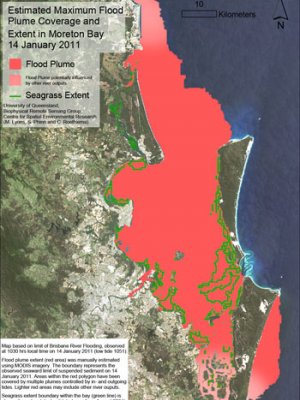
UQ experts are helping to accurately map and measure the health of Moreton Bay following the recent floods.
School of Geography, Planning and Environmental Management staff Professor Stuart Phinn, Dr Chris Roelfsema, Associate Professor Ron Johnstone and PhD student Mitch Lyons are working with the South East Queensland Healthy Waterways Scientific Taskforce to provide a detailed picture of the short and long term effects of the flood on the area.
“The plume maps and our interpretation helped people quickly understand where and when the plume was moving and the extent of Moreton Bay that would receive sediment from the plume,” Professor Phinn said.
The visualisations have been used by scientists sampling sediment and seagrass immediately after the flood to determine where to collect field samples to analyse water quality, sediment deposition and seagrass properties.
"Our initial role was to help map the extent of the flood plume but the next step will be in post-flood mapping of the extent, species composition and amount of seagrass across Moreton Bay,” Professor Phinn said.
Mr Lyons’s doctoral research examines changes in seagrass cover in the eastern section of the bay from 1972 and has produced a map showing the extent of coverage of the Moreton Bay flood plume in relation to seagrass beds.
"In the following weeks and months, Moreton Bay will be closely monitored to assess the impact of suspended sediment, nutrient and toxin input as well as associated algal blooms," he said.
The range of seagrass cover variability observed over almost four decades would help determine whether any significant changes have taken place.
“Seagrass may suffer due to reduced salinity produced by freshwater outflows, increased levels of pollutants in the water, sediment settling on its leaves, and reduced sunlight due to turbid waters. As seagrass is a nursery ground and food source it could also impact on other marine life,” Dr Roelfsema said.
Professor Phinn said larger tidal ranges, increased swell and winds in the bay during the week immediately following the flood peak may reduce some impacts. However, the full extent of these may not be known for months.
The team will produce detailed seagrass maps from a combination of photos taken by snorkelers and divers linked to GPS locations and very high spatial resolution satellite data.
This data is combined using software that mimics the human visual system and allows seagrass features to be mapped based on features such as shape, size and colour.
The maps will be used by the groups responsible for water quality in the bay including the Healthy Waterways partnership and the Department of Environment and Resource Management and the Department of Employment and Economic Development and Innovation.
The team will also assist with developing techniques for mapping flood effects and impacts from a range of satellite image data provided by space agencies around the world to the Queensland Government through the International Space and Major Disasters international charter.
This research is conducted through the Joint Remote Sensing Research Program, a formal collaboration between UQ and the Queensland, New South Wales and Victorian governments.
Media: Kate Swanson (07 3346 7406, k.swanson@uq.edu.au)
.jpg)









